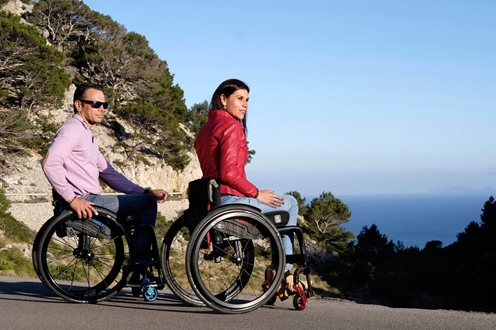frequently asked Wheelchair questions
Powerchair batteries should be charged after every use for no less than 8 hours, in most situations clients use the chair throughout the day, put it on charge in the evening and the take it off charge the next morning. It is important to note that if the chair is not used for a particular length of time that the chair still needs to be charged, if possible select a day during the week and put the chair on an overnight charge every week it’s not in use.
There are too many variables such as chair type, battery size, powered seat functions in use, charge process, terrain etc to give any exact information however there are certain manufacturers that build in software for you to connect to and receive up-to date information on battery life.
The high risk nature of a cushion is indeed relating to pressure relief but not necessarily because of any historical issues. The support provided by this level of cushion offers structural positioning as well as pressure relief for anyone sitting for a considerable length of time. Meaning that regardless of your situation, if you’re spending a lot of time in your chair then it is very important that you invest in a suitable cushion to support you for the duration.
In terms of manoeuvrability a compact, mid-wheel drive (MWD) chair is definitely the superior option. Due to the main wheels being centred directly under the seat it allows the chair to turn around that axis, the wheels turn in opposite directions to each other similar to a rowing boat or caterpillar tracks when turning which keeps the turning circle extremely tight. In addition to this, unlike a front-wheel drive (FWD) or a rear-wheel drive (RWD) chair there is absolutely no obstruction either behind or in front of you. View our range of indoor powerchairs here.
Yes they can, all of the prescriptive paediatric chairs supplied by CMS have the ability to adjust by 2-3” inches in either width or depth. The only thing to bear in mind is the change in seat cushion and potentially backrest height.
The amber turtle appears when the speed limiter/inhibit has been activated, this is primarily for safety and could be caused by a degree of powered tilt, elevating the chair past a certain point or reclining the backrest beyond a predetermined angle. The turtle could also turn red which would prevent the chair from moving altogether. If none of the above are in use, contact your engineer to ensure everything is in place and operational.
This very much depends on your experience with active wheelchairs and the position of the wheels. If your wheels are forward of your pelvis then the chair will be tipper and more active (easier to propel and manoeuvre) whereas if the wheels are positioned rear of your pelvis then the chair will be more passive (stable but harder to propel). For a first time active wheelchair user with an active setup, anti-tippers are advised to allow your confidence to grow. You can soon take them off when you’re comfortable enough.
Yes you can, you may not be able to go as fast as you normally would for safety reasons but you will still be mobile.
frequently asked questions
Please get in contact today if you have any more wheelchair questions that weren't answered in the frequently asked questions above. We're always happy to help answer questions or any other queries you may have. Free free to call us today.

